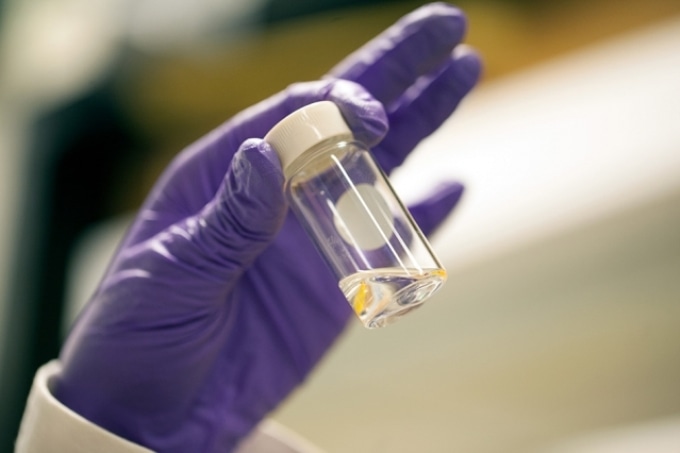Nov 9 2017
Oil and water cannot mix together and this continues to remain that way. The phenomenon is so popular that it has become a common expression for describing any two objects that do not go well together. Now, researchers at MIT have developed a new method that might turn that expression on its head, providing a means to get the two substances to mix together and remain stable for a long period of time — without any need for shaking. The process could be used in processed foods, cosmetics, and pharmaceuticals, among other areas.
 Graduate student Ingrid Guha holds a jar containing a clear liquid that looks like water to the naked eye, but it’s actually an emulsion of oil and water at the nanoscale. (Credit: Melanie Gonick, MIT)
Graduate student Ingrid Guha holds a jar containing a clear liquid that looks like water to the naked eye, but it’s actually an emulsion of oil and water at the nanoscale. (Credit: Melanie Gonick, MIT)
In the new process, an oil bath containing a tiny amount of a surfactant (a soap-like substance) was first cooled, and then water vapor from the surrounding was allowed to air condense onto the surface of the oil. Experimental studies have demonstrated that this method can create small and uniform water droplets on the surface that subsequently sink into the oil. The size of the water droplets can also be controlled by modifying the amount of surfactant.
The results of the study, performed by MIT graduate student Ingrid Guha, associate professor Kripa Varanasi, and former postdoc Sushant Anand, are published in the journal, Nature Communications.
Anyone who has used salad dressing would know that even if the mixture is shaken vigorously, the vinegar (a water-based solution) and the oil will separate quickly. However, for many applications such as food-processing methods and new drug-delivery systems, it is essential to mix the oil in water (or water in oil) to form small droplets, which have to remain small and not coalesce into larger droplets and ultimately separate from the other liquid. These tiny droplets measure just a few hundred nanometers across and are too small to be viewed with the naked eye.
In industrial processes, these emulsions are typically made by mechanically shaking the mix or utilizing sound waves to set up strong vibrations inside the liquid, a process known as sonicating. However, both these processes “require a lot of energy,” Varanasi says, “and the finer the drops, the more energy it takes.” On the other hand, “our approach is very energy inexpensive,” he adds.
The key to overcoming that separation is to have really small, nanoscale droplets, when the drops are small, gravity can’t overcome them,” and they can continue to remain suspended for an indefinite period of time.
Ingrid Guha, MIT graduate student
For the latest process, the researchers set up an oil reservoir with an added surfactant that can attach to both water and oil molecules. This was placed within a chamber with extremely humid air and then the oil was cooled. Similar to a glass of cold water on a hot summer day, the water vapor precipitates because of the colder surface, and the condensing water subsequently forms water droplets on the surface that spread across the mixture of oil and surfactant. The team observed that the sizes of these water droplets were quite uniform. “If you get the chemistry just right, you can get just the right dispersion,” Guha says. The droplet sizes can be controlled well by adjusting the amount of surfactant in the oil.
In their experiments, the researchers created nanoscale emulsions that remained stable even after several of months, unlike the few minutes that would normally take for the same oil-water mixture to separate without the presence of surfactant. “The droplets stay so small that they’re hard to see even under a microscope,” Guha says.
The sonicating or shaking method takes the bulk, separate masses of water and oil and then slowly breaks them down into smaller drops. This process is called a “top down” approach. By contrast, the condensation method begins immediately with the small droplets condensing out from the vapor, which the research team termed as a bottom-up approach.
“By cloaking the freshly condensed nanoscale water droplets with oil, we are taking advantage of the inherent nature of phase-change and spreading phenomena,” Varanasi says.
Our bottom-up approach of creating nanoscale emulsions is highly scalable owing to the simplicity of the process, we have uncovered many new phenomena during this work. We have found how the presence of surfactant can change the oil and water interactions under such conditions, promoting oil spreading on water droplets and stabilizing them at the nanoscale.
Sushant Anand, postdoc in MIT
According to the MIT team, the bottom-up approach should work with a wide range of surfactants and oils, and now with the discovery of this novel process, their findings “provide a kind of design guideline for someone to use” for a specific type of application, Varanasi says.
“It’s such an important thing,” he says, because “foods and pharmaceuticals always have an expiration date,” and usually that is due to the instability of the emulsions in them. In the experiments, a specific but widely used surfactant was used; however, other varieties of surfactants are also available, including those approved for food-grade products.
Additionally, Guha says, “we envision that you could use multiple liquids and make much more complex emulsions.” And apart from being used in drugs, cosmetics, and food, the method could also have other uses, for instance the oil and gas sector, where fluids like the drilling “muds” sent down wells are also emulsions, says Varanasi.
The National Science Foundation, the MIT Energy Initiative, and a Society in Science fellowship funded the study. Anand, the study co-author and a former postdoc at MIT, is now an assistant professor at the University of Illinois.
A new way to mix oil and water